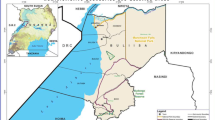Abstract
In the humid and subhumid tropics, trypanosomosis is an economically important zoonotic protozoan disease of the commonly kept farm animal species and their wild relatives. For example, more than 20% of the humid western and southwestern Ethiopia, which is home to more than 14 million heads of cattle, is under varying levels of trypanosomosis risk. Our study was, therefore, initiated to document farmers’ perception on trypanosomosis and Sheko’s trypanotolerance character. Our findings showed that trypanosomosis was the most frequently reported cattle disease in the Bench Maji Zone. Accordingly, 76.7% of the farmers reported the epidemiological importance of trypanosomosis, and they also noted that trypanosomosis on average accounted for 63.0% of annualized cattle death. The reported signs of trypanosomosis and trypanotolerance indicators were consistent with literature reports. Moreover, 66.7% of the farmers reported Sheko’s trypanotolerance character. In the course of time, smallholder farmers have developed ethnoveterinary practices that are mainly used to prevent the landing of vector flies on the animal. Wet and warm seasons of the year, i.e., spring and, to some extent, the beginning of summer and autumn, were reported as peak periods of trypanosomosis risk. Therefore, this showed the need for incorporating farmers’ knowledge in trypanosomosis control programs.

Similar content being viewed by others
References
Adewunmi, C.O., Agbedahunsi, J.M., Adebajo, A.C., Aladesanmi, A.J., Murphy, N and Wando, J., 2001. Ethno-veterinary medicine: screening of Nigerian medicinal plants for trypanocidal properties, Journal of Ethnopharmacology, 77, 19–24.
Alberro, M. and Haile-Mariam, S., 1982. The indigenous cattle of Ethiopia: Part I, World Animal Review, 41, 2–10.
Bradley, D.G., MacHugh D.E., Cunningham P. and Loftus, R.T. 1996. Mitochondrial diversity and the origins of African and European cattle. Evolution/anthropology, Proceedings of the National Academic of Science, 93 (10), 5131–5135.
Dagnachew, S., Sangwan A.K. and Abebe, G., 2005. Epidemiology of bovine trypanosomosis in the Abay (Blue Nile) basin areas of northwest Ethiopia, Revue d’élevage et de médecine vétérinaire des pays tropicaux, 58 (3), 151–157.
Dayo, G. -K., Thevenon, S., Berthier, D., Moazami-Goudarzi, K., Denis, C., Cuny, G., Eggen, A. and Gautier, M., 2009. Detection of selection signatures within candidate regions underlying trypanotolerance in outbred cattle populations, Molecular Ecology, 18, 1801–1813.
Desta, T.T., Ayalew, W. and Hegde, B. P., 2011. Breed and trait preferences of Sheko cattle keepers in southwestern Ethiopia, Tropical Animal Health and Production, 43, 851–856.
Fall, A., Diack, A., Diaité, A., Seye, M. and d’Ieteren, G.D.M., 1999. Tsetse challenge, trypanosome and helminth infection in relation to productivity of village Ndama cattle in Senegal, Veterinary Parasitology, 81, 235–247.
Faulkner, D.E. and Epstein, H., 1957. The indigenous cattle of the British dependant territories in Africa, Colonial advisory council of agriculture, animal health and forestry, Publication No 5 Colonial office, London.
Grace, D., Randolph, T., Affognon, H., Dramane, D., Diall, O. and Clausen, P.H., 2009. Characterisation and validation of farmers’ knowledge and practice of cattle trypanosomosis management in the cotton zone of West Africa, Acta Tropica, 111, 137–143.
Hanotte, O., Tawah C.L., Bradley D.G., Okomo M., Verjee Y., Ochieng J. and Rege, J.E.O., 2000. Geographic distribution and frequency of a taurine Bos taurus and an indicine Bos indicus Y specific allele amongst Sub-Saharan African cattle breeds, Molecular Ecology, 9, 387–396.
Kebede, N., Fetene, T. and Animut, A., 2009. Prevalence of trypanosomosis of small ruminants in Guangua district of Awi Zone, northwestern Ethiopia, Journal of Infection in Developing Countries, 3 (3), 245–246.
Lemecha, H., Mulatu, W., Hussien, I., Rege, E., Tekle, T., Abdicho, S. and Ayalew, W., 2006. Response of four indigenous cattle breeds to natural tsetse and trypanosomosis challenge in the Ghibe valley of Ethiopia, Veterinary Parasitology, 141, 165–176.
Mihret, A. and Mamo, G., 2007. Bovine trypanosomosis in three districts of East Gojjam Zone bordering the Blue Nile river in Ethiopia, Journal of Infection in Developing Countries, 1(3), 321–325.
MOA, 1995. Ruminant Livestock Development Strategy (RLDS). Ministry of Agriculture (MOA), Addis Ababa, Ethiopia.
Samdi, S.M., Abenga, J.N., Attahir, A., Haruna, M.K., Wayo, B.M., Fajinmi, A.O., Sumayin, H.M., Usman, A.O., Hussaina, J.Z., Muhammad, H., Yarnap, J.E., Ovbagbedia, R.P. and Abdullahi, R.A., 2010, Impact of trypanosomosis on food security in Nigeria: A review, International Journal of Animal and Veterinary Advances, 2 (2), 47–50.
SAS, 1999. Institute Inc. SAS/STAT User’s Guide, Version 8, (Cary, NC, SAS Institute Inc).
Stein, J., Ayalew, W., Rege, J. E. O., Mulatu, W., Malmfors, B., Dessie, T. and Philipsson, J., 2009. Livestock keeper perceptions of four indigenous cattle breeds in tsetse infested areas of Ethiopia, Tropical Animal Health and Production, 41 (7), 1335–1346.
Stein, J., Ayalew, W., Rege, Ed., Mulatu, W., Lemecha, H., Tadesse, Y., Tekle, T. and Philipssona, J., 2011. Trypanosomosis and phenotypic features of four indigenous cattle breeds in an Ethiopian field study, Veterinary Parasitology, 178, 40–47.
Taye, T., 2005. On-farm phenotypic characterization of Sheko breed of cattle and their habitat in Bench Maji Zone, Ethiopia, (unpublished MSc Thesis, Alemaya University).
Acknowledgments
Those farmers who participated in the individual interview and focus group discussions are duly acknowledged for sharing their knowledge and working time. The study cost was covered by the Ministry of Agriculture and Rural Development, and the International Livestock Research Institute had awarded graduate fellow status and office facilities to the first author while he is working on his MSc thesis project.
Author information
Authors and Affiliations
Corresponding author
Rights and permissions
About this article
Cite this article
Desta, T.T., Ayalew, W. & Hegde, P.B. Farmers’ perceptions on trypanosomosis and trypanotolerance character of the taurine Sheko. Trop Anim Health Prod 44, 609–616 (2012). https://doi.org/10.1007/s11250-011-9943-9
Accepted:
Published:
Issue Date:
DOI: https://doi.org/10.1007/s11250-011-9943-9




